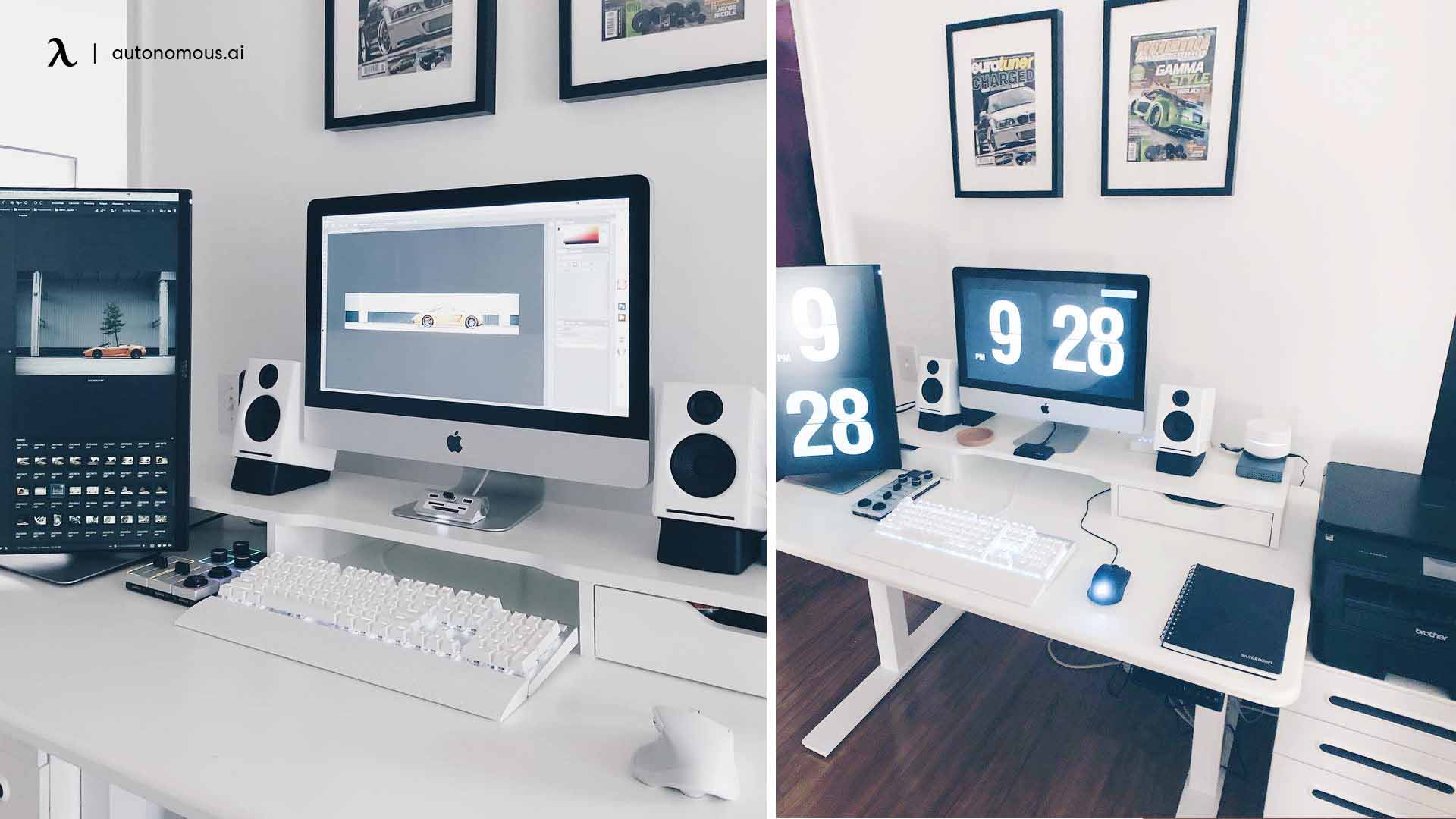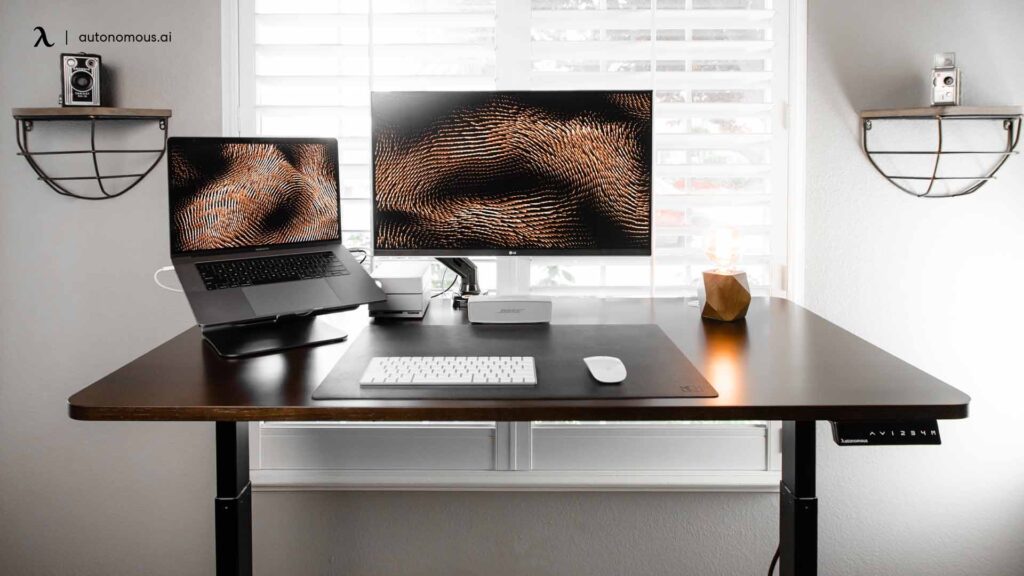
In today’s modern world, where technology plays an increasingly prominent role in our lives, the idea of a minimalist setup can be quite intriguing. Picture this: a clean and clutter-free environment, where only essential items are present, creating a sense of calm and tranquility. But what about our beloved devices? Are wireless devices the key to achieving the minimalist lifestyle we yearn for without sacrificing functionality?
In this article, we will explore the merits of wireless devices in a minimalist setup. We will delve into the advantages they offer, such as seamless connectivity, reduced cable clutter, and the freedom to work and play without being tethered to a specific location. Furthermore, we will examine the challenges of relying solely on wireless technology, including potential connectivity issues and the need for reliable power sources. By the end, you will have a clearer understanding of whether wireless devices truly enhance a minimalist setup or if they may introduce unnecessary complexities. So sit back, relax, and let us guide you through this captivating journey.
1. Convenience
When it comes to setting up your home or office space, convenience is key. Wireless devices offer several advantages in terms of convenience, making them an ideal choice for a minimalist setup.
1.1 Increased Mobility
One of the main advantages of wireless devices is the increased mobility they provide. With no cables to worry about, you have the freedom to move your devices around as needed. Whether you’re rearranging your workspace or simply want to use your device in a different location, wireless technology allows for effortless mobility.
1.2 Easy Installation
Gone are the days of struggling with tangled cables and complex installations. Wireless devices are incredibly easy to set up. With just a few simple steps, you can have your wireless speakers, printers, or even security cameras up and running in no time. This streamlined installation process saves you both time and effort.
1.3 Flexible Placement
Wireless devices offer the flexibility to place them wherever you choose, without being limited by the proximity of power outlets or the length of cables. This means you can position your speakers in the perfect spots for optimal sound quality, or place your security cameras in strategic locations without worrying about wiring constraints. The ability to freely place your devices enhances the overall convenience and functionality of your minimalist setup.
2. Cable Management
A cluttered space can hinder productivity and create a visually chaotic environment. Wireless devices eliminate the need for excessive cables, providing a solution for effective cable management.
2.1 Reduction of Clutter
One of the biggest benefits of wireless devices is the reduction of clutter. Traditional setups with numerous cables can create a messy and disorganized space. By eliminating cables, you can achieve a cleaner and more streamlined aesthetic in your minimalist setup. It’s easier to focus and stay organized when you’re not constantly dealing with tangled cables and unsightly wires.
2.2 Improved Aesthetics
In addition to reducing clutter, wireless devices also contribute to an improved aesthetic. Without the visual distraction of cables, your space can appear sleek and minimalistic. This clean and organized look not only enhances the overall ambiance but also creates a sense of calm and tranquility, promoting a more productive and inviting environment.
2.3 Easier Cleaning
Cleaning becomes a breeze when you don’t have to navigate around cables and wires. With wireless devices, there are no cables to dust or untangle, simplifying the cleaning process. Maintaining a clean and organized workspace becomes much more manageable, allowing you to focus on the task at hand and avoid potential distractions.

3. Portability
If you value portability and the ability to easily move your devices, wireless technology is the way to go. Wireless devices offer a range of benefits when it comes to portability.
3.1 Lightweight and Compact
Wireless devices are often designed to be lightweight and compact, making them easily transportable. Whether you’re moving from room to room or traveling with your devices, their portability ensures you can effortlessly take them wherever you go. The compact size and lightweight nature of wireless devices also make them perfect for those who are constantly on the move or have limited space.
3.2 Ease of Transport
With wireless devices, you can say goodbye to the hassle of bundling up cables and worrying about tangled wires. The absence of cables simplifies the process of transporting your devices. Whether you’re moving your speakers to a different location or taking your wireless headphones on a trip, you can easily pack them without the worry of damaging or tangling any cables.
3.3 Simplified Setup
Another advantage of wireless devices when it comes to portability is the simplified setup process. Setting up a wireless device typically involves minimal steps and doesn’t require any additional tools or accessories. This makes it convenient to quickly set up your devices in different locations without the need for complex installations or adjustments.
4. Versatility
Wireless devices offer a high level of versatility, making them suitable for a wide range of applications. Whether you’re using them for work, entertainment, or home automation, wireless technology provides numerous benefits.
4.1 Compatibility with Multiple Devices
Wireless devices are designed with compatibility in mind, allowing them to seamlessly connect with a variety of devices. From smartphones and laptops to smart home hubs, wireless technology enables you to easily integrate your devices and create a cohesive and interconnected system. This versatility ensures that you can use your wireless devices across multiple platforms and enjoy a hassle-free experience.
4.2 Freedom of Movement
With wireless devices, you’re not confined to a specific area or limited by the length of cables. This freedom of movement allows you to enjoy your favorite music, movies, or games without being tethered to a specific spot. Whether you’re moving around the room or going about your daily activities, wireless technology ensures you can stay connected and in control, enhancing your overall user experience.
4.3 Integration with Smart Home Technology
Wireless devices seamlessly integrate with smart home technology, offering a range of possibilities for creating a modern and interconnected living space. From controlling your lights and thermostats to monitoring your security cameras, wireless devices provide the foundation for a smart home setup. The ability to connect and control your devices wirelessly adds convenience and sophistication to your minimalist lifestyle.

5. Cost
Cost is an important factor when considering any purchase. Wireless devices may seem more expensive upfront, but they offer various cost-related advantages in the long run.
5.1 Initial Investment
While wireless devices may have a slightly higher upfront cost compared to their wired counterparts, this initial investment is often justified by the convenience and benefits they provide. It’s important to consider the long-term value and versatility that wireless devices offer before making a purchasing decision. The initial investment can pay off in terms of improved productivity, reduced maintenance costs, and potential savings in the long run.
5.2 Reduced Maintenance
Wireless devices generally require less maintenance compared to traditional wired devices. Without the need for cables, there’s less risk of cables breaking or getting damaged over time. Additionally, wireless devices often come with advanced features such as automatic software updates, minimizing the need for manual intervention and reducing maintenance costs associated with keeping your devices up to date.
5.3 Potential for Long-Term Savings
While wireless devices may have a higher upfront cost, they can provide potential long-term savings. The reduced maintenance costs and increased durability of wireless devices can result in fewer repairs or replacements, saving you money in the long run. Furthermore, wireless technology continually evolves, and investing in wireless devices ensures that you’ll be equipped to take advantage of future advancements without needing to replace your entire setup.
6. Sound Quality
If you’re an audiophile or simply appreciate high-quality sound, wireless devices have made significant advancements in sound quality, offering an immersive audio experience.
6.1 Advancements in Wireless Technology
Wireless technology has come a long way in terms of sound quality. With the introduction of high-definition audio codecs and advanced signal processing algorithms, wireless devices can deliver audio quality that rivals their wired counterparts. The advancements in wireless technology ensure that you can enjoy crystal-clear sound without sacrificing convenience or mobility.
6.2 High-Quality Audio Transmission
Wireless devices, such as wireless speakers and headphones, are designed to deliver high-quality audio transmission. They utilize technologies like Bluetooth or Wi-Fi to ensure a reliable and seamless connection with your audio source. Whether you’re listening to music, watching movies, or gaming, wireless devices can provide an immersive and high-fidelity sound experience that enhances your overall enjoyment.
6.3 Immersive Surround Sound
Wireless home theater systems and surround sound setups have become increasingly popular due to their ability to create a truly immersive audio experience. With wireless speakers strategically placed around your space, you can enjoy the sensation of sound coming from all directions, delivering a cinematic experience within the comfort of your home. Wireless surround sound systems eliminate the need for extensive wiring, making it easier to achieve a clutter-free and minimalist setup without compromising on sound quality.

7. Connectivity
Seamless connectivity is crucial in today’s interconnected world. Wireless devices offer a range of advantages when it comes to connectivity, ensuring that your devices work together seamlessly.
7.1 Seamless Integration
Wireless devices are designed to seamlessly integrate with each other, allowing for easy connectivity and synchronization. Whether you’re connecting your wireless headphones to your smartphone or your smart TV to your wireless speakers, the process is simple and straightforward. This seamless integration ensures that your devices work together harmoniously, enhancing your overall user experience and simplifying your daily tasks.
7.2 Easy Expansion
Wireless technology allows for easy expansion of your setup without the need for complex wiring or additional infrastructure. If you want to add more devices to your existing setup, such as additional speakers or smart home devices, the process is as simple as connecting them wirelessly. This ease of expansion ensures that your setup can grow and adapt with your evolving needs, providing a flexible and scalable solution.
7.3 Enhanced Networking
Wireless devices enable enhanced networking capabilities, allowing you to create a connected ecosystem within your home or office. From sharing files and printers seamlessly to setting up multi-device networking, wireless technology provides a fast and reliable connection. This enhanced networking capability improves collaboration and productivity, ensuring that you can effortlessly work across multiple devices without any connectivity issues.
8. Environmental Impact
In today’s eco-conscious world, considering the environmental impact of our choices is essential. Wireless devices offer several benefits when it comes to reducing our ecological footprint.
8.1 Reduced Energy Consumption
Wireless devices generally consume less energy compared to their wired counterparts. This reduced energy consumption not only helps to lower your utility bills but also contributes to a more sustainable lifestyle. With wireless devices, you’re not constantly powering cables and adapters, resulting in less energy waste and a decreased environmental impact.
8.2 Minimized Waste
Traditional wired devices often come with a multitude of cables, adapters, and connectors. Over time, these cables can become obsolete or damaged, resulting in unnecessary electronic waste. With wireless devices, the need for excessive cables is eliminated, reducing the amount of e-waste generated. This contributes to a more sustainable and eco-friendly approach to technology consumption.
8.3 Eco-Friendly Manufacturing
Wireless devices are manufactured with sustainability in mind. Many manufacturers strive to incorporate eco-friendly materials and practices into the production of their wireless devices. This includes the use of recyclable materials, energy-efficient manufacturing processes, and reduction of harmful substances. By choosing wireless devices, you’re supporting manufacturers that prioritize sustainability and environmental responsibility.

9. Reliability
Wireless technology has significantly improved in terms of reliability, addressing concerns about signal stability, redundancy, and physical damage.
9.1 Advanced Signal Stability
Wireless devices now benefit from improved signal stability, ensuring a consistent and uninterrupted connection. Signal interference, which was once a common issue, has been minimized through advancements in wireless technology. Whether you’re streaming music, video conferencing, or transferring files, you can rely on a stable and reliable wireless connection.
9.2 Built-in Redundancy
To further enhance reliability, wireless devices often incorporate built-in redundancy features. This means that if one component or connection fails, there are alternative pathways or backup options to ensure continuous operation. Built-in redundancy minimizes the risk of downtime or interruptions, making wireless devices a reliable choice for both personal and professional use.
9.3 Reduced Risk of Physical Damage
With traditional wired setups, there’s always a risk of cables getting damaged due to wear and tear or accidental incidents. Wireless devices eliminate this risk, as there are no cables to trip over, damage, or accidentally yank out of their sockets. This increases the overall durability and longevity of your devices, reducing the need for repairs or replacements.
10. Security
Security is a paramount concern when it comes to technology. Wireless devices offer several security features that help protect your data and ensure a safe and secure environment.
10.1 Encryption and Authentication
Wireless devices utilize encryption and authentication protocols to secure data transmission. This means that your data is protected from potential eavesdroppers or unauthorized access. Modern wireless technologies often employ robust encryption algorithms, ensuring that your sensitive information remains secure and private.
10.2 Reduced Risk of Physical Tampering
With wired devices, there’s always a risk of physical tampering. Cables can be easily manipulated or compromised, potentially compromising the security of your devices or network. Wireless devices eliminate this risk, as there are no cables to tamper with. This adds an extra layer of security to your setup, ensuring that your devices remain protected against physical intrusion.
10.3 Protection against Interference
Wireless devices are designed to be resilient against interference, both from external sources and neighboring devices. Advanced wireless technologies employ techniques to mitigate the impact of interference, ensuring a stable and secure connection. This protection against interference safeguards your network from potential threats, providing peace of mind and a secure environment for your devices and data.
In conclusion, wireless devices offer a range of benefits for a minimalist setup. From increased convenience and improved cable management to enhanced portability and versatility, wireless technology provides a seamless and user-friendly experience. With advancements in sound quality, connectivity, and security, wireless devices have become an integral part of modern living. Embracing wireless technology not only simplifies your setup but also contributes to a cleaner and more sustainable environment. So, if you’re looking to create a minimalist space that offers convenience, flexibility, and a clutter-free aesthetic, wireless devices are undoubtedly the way to go.

